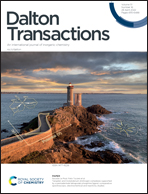Magnetic interaction of photoexcited terbium–porphyrin complexes with non-aromatic ligands having different symmetries†
Abstract
Interaction between the total angular momentum (J) of 4f electrons in lanthanides and the orbital angular momentum (L) of porphyrins in the photoexcited states was investigated by temperature-dependent and magnetic circular dichroism (MCD) for 5,10,15,20-tetraphenylporphyrinato (TPP) terbium(III) complexes with two different non-aromatic ligands i.e. 12-crown-4(1,4,7,10-tetraoxacyclododecane) and 1-aza-12-crown-4(1,4,7-trioxa-10-azacyclododecane). The two cases with different ligands were examined in order to understand how magnetic interaction depends on the symmetry of the non-aromatic ligands. The three absorption bands in the visible region, B(0,0), Q(1,0), and Q(0,0) bands, showed temperature-dependent MCD A term. For each band, the J–L interaction was determined from the simulation-based fitting to experimental  ratios. An increase in the magnitude of the J–L interaction was observed when the second ligand was the aza-crown with a lower symmetry. Ab initio RASSCF/RASSI calculations were performed to explore the effect of the difference in the second ligand to the ligand centred excited states and the ligand-field-splitting structure on the metal-centred ground multiplet of J = 6.
ratios. An increase in the magnitude of the J–L interaction was observed when the second ligand was the aza-crown with a lower symmetry. Ab initio RASSCF/RASSI calculations were performed to explore the effect of the difference in the second ligand to the ligand centred excited states and the ligand-field-splitting structure on the metal-centred ground multiplet of J = 6.



 Please wait while we load your content...
Please wait while we load your content...